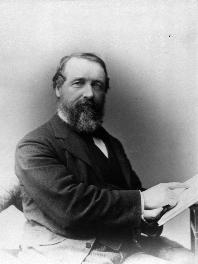 The influence of Henry Chadwick on the game of baseball cannot be overstated. As a journalist in New York, he invented the newspaper box score, and introduced such statistics such as batting average and ERA. He invented and popularized such terms as "assist," "cut off," "battery," "base on balls," "fungo," "double play," "error," and "goose egg." He was also instrumental in setting many of the modern game's early rules, and he edited numerous annual baseball guides.
The influence of Henry Chadwick on the game of baseball cannot be overstated. As a journalist in New York, he invented the newspaper box score, and introduced such statistics such as batting average and ERA. He invented and popularized such terms as "assist," "cut off," "battery," "base on balls," "fungo," "double play," "error," and "goose egg." He was also instrumental in setting many of the modern game's early rules, and he edited numerous annual baseball guides.To enable sportswriters like himself to record every play of a game, Chadwick assigned each position a number from 1-9 and invented a series of letter symbols. It is believed he is responsible for "K" for strikeout ("S" was already used for single).
Chadwick was born in Exeter, England, in 1824 and came to America at age 14. He began writing for the Long Island Star in 1844, and began covering cricket and other sports for the New York Times, Brooklyn Eagle and New York Clipper in 1856. During the Civil War, he was a reporter for the New York Tribune. He was also a pianist, songwriter, and drama critic. Chadwick died in Brooklyn on April 20, 1908, and was enshrined in baseball's Hall of Fame in 1938, the only writer elected to the Hall itself (as opposed to the Writers Wing).
Walter Camp writes:
Chadwick was actually a baseball promoter who used writing as a tool. ... He wrote descriptive accounts of baseball games and also gave his readers an insight into the game that no one else could provide. A typical Chadwick article would include a description of the weather, the crowd, and a recap of each inning played.In 1861, Chadwick wrote:
In order to obtain an accurate estimate of a player's skill, an analysis, both of his play at the bat and in the field, should be made, inclusive of the way in which he was put out; and that this may be done, it is requisite that all ... contests should be recorded in a uniform manner.Alan Schwarz, in his book The Numbers Game, notes the "staggeringly detailed statistics" in a 1858 box score. Besides the usual runs and outs, there were nine other columns for each player:
... for his defense, his total of fly catches, bound catches (balls caught on one bounce, which then counted as outs), and times putting out a runner on the bases; for his batting, times put out on flies, bounds, and foul balls; and for his base running, how often he was put out at first, second, and third bases (not home, curiously). These tallies gave a reader a vivid snapshot of how every player's bat, legs, and glove impacted a win or loss.Frederick Ivor-Campbell:
Chadwick's detailed scoring enabled him to write more precise game reports than his predecessors, and led him to develop and compile the game's first detailed statistics. Before Chadwick, box scores listed only the participants and their outs made and runs scored. Over his first decade of baseball reporting, Chad developed his own scoring system, introducing it to the public in 1867. A difficult system to master, it was eventually superseded by simpler systems, but with it Chadwick produced the first genuinely informative box scores, and many of the most basic player statistics ...Jules Tygiel notes that Chadwick
invented the game's historical essence. The ways in which Americans would absorb and analyze baseball from the late nineteenth century to the present emerged largely from Chadwick's vision, innovation, and reforming passion.As the years went on, Chadwick became a bit of a crank -- he may have also invented the attitude of the game was better in the old days. He railed against the various evils of the game -- like home runs -- and refused to print statistics he no longer believed in.
Camp adds:
Chadwick was witness to an increase in ticket prices, which owners used to raise revenues, while giving players the share of the profits that they demanded. Chadwick believed that both sides were corrupting the game with their greed.Chadwick's ideal game was a taut 1-0 battle and he routinely lamented the "modern player" who was more interested in padding his own hit and run statistics (which would then increase his market value) that team-oriented acts like bunting and moving runners over.
Chadwick is buried in Brooklyn's Green-Wood Cemetery, where Laura and I spent a few hours yesterday. Charles Ebbets, when he owned the Brooklyn Dodgers, organized annual pilgrimages to Chadwick's grave; Ebbets himself is buried a short distance away.
Besides being topped by a large granite baseball and having crossed bats and catcher's equipment on the sides of the monument, check out the baselines and four stone bases (complete with belt buckles)!
No comments:
Post a Comment